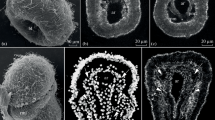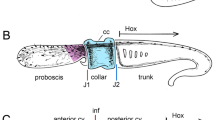Abstract
The Ecdysozoa-hypothesis on the origin of arthropods questions the homology of segmentation in arthropods, onychophorans, and annelids. The implication of convergent gain of metamery in these groups seems to conflict particularly with the correspondence in the development of serial coelomic cavities and metanephridia. Ultrastructural studies of the mesoderm development in Onychophora revealed that main correspondence with the state in annelids concerns the involvement of epithelial lining cells of the embryonic coelomic cavities in the formation of the visceral and somatic musculature. The significance of this correspondence, however, remained unclear as comparable data on the state in arthropods were still missing. Developmental studies on selected representatives covering all major arthropod subgroups aim to fill in this gap. Data were raised by a combination of transmission electron microscopy and fluorescent stainings of the muscular system and nuclei for the anostracan crustacean Artemia salina. In this species, putative transitory coelomic cavities proved to be absent in all trunk segments. In the second antennal and second maxillary segments small, compact nephridial anlagen develop into a sacculus and excretory duct. The sacculus originates from the terminal cells of the nephridial duct, which is formed in advance. The lumen of the sacculus is inconspicuous in its earliest functional stage and later enlarges to a bulb; it accordingly represents no remnant of any primarily large coelomic cavity. The muscular system is entirely formed prior to and independent of coelomic or nephridial anlagen. Visceral and somatic mesoderm already separate in the caudal body region. Transitory segmental clusters of mesodermal cells are composed of somatic cells only and accordingly represent no “somites”. Our observations overall do not provide any support for the homology of coelomic cavities in annelids and arthropods.







Similar content being viewed by others
References
Anderson DT (1967) Larval development and segment formation in the branchipod crustaceans Limnadia stanleyana King (Conchostraca) and Artemia salina (L.) (Anostraca). Aust J ZooI 15:47–91. doi:10.1071/ZO9670047
Anderson DT (1973) Embryology and phylogeny in annelids and arthropods. Pergamon Press, Oxford
Arnaud F, Bamber RN (1987) The biology of Pycnogonida. Adv Mar Biol 24:1–96. doi:10.1016/S0065-2881(08)60073-5
Ax P (1996) Multicellular animals. a new approach to the phylogenetic order in nature, vol 1. Springer, Heidelberg
Bartolomaeus T (1993) Die Leibeshöhlenverhältnisse und Nierenorgane der Bilateria—Ultrastruktur, Entwicklung und Evolution. Universität Göttingen, Habilitationsschrift
Bartolomaeus T (1994) On the ultrastructure of the coelomic lining in annelids, echiurids and sipunculids. Microfauna Marina 9:171–220
Bartolomaeus T, Quast B (2005) Structure and development of nephridia in Annelida and related taxa. Hydrobiologia 535/536:139–164. doi:10.1007/s10750-004-1840-z
Bartolomaeus T, Ruhberg H (1999) Ultrastructure of the body cavity lining in embryos of Epiperipatus biolleyi (Peripatidae, Onychophora). Invertebr Biol 118:165–174. doi:10.2307/3227057
Benesch R (1969) Zur Ontogenie und Morphologie von Artemia salina L. Zool Jb Anat 86:307–458
Cannon HG (1924) On the development of an estheriid crustacean. Philos Trans R Soc B 212:395–430. doi:10.1098/rstb.1924.0010
Criel GRJ (1991) Ontogeny of Artemia. In: Browne RA, Sorgeloos P, Trotman CNA (eds) Artemia biology. CRC Press, Boca Raton, pp 155–185
Dunn CW, Hejnol A, Matus DQ, Pang K, Browne WE, Smith SA, Seaver E, Rouse GW, Obst M, Edgecombe GD, Sörensen MV, Haddock SHD, Schmidt-Rhaesa A, Okusu A, Kristensen RM, Wheeler WC, Martindale MQ, Giribet G (2008) Broad phylogenomic sampling improves resolution of the animal tree of life. Nature 452:745–749. doi:10.1038/nature06614
Edgecombe GD (2004) Morphological data, extant Myriapoda, and the myriapod stem-group. Contrib Zool 73(3):207–252
Fahrenbach WH, Arango CP (2007) Microscopic anatomy of Pycnogonida: II. Digestive system. III. Excretory system. J Morphol 268:917–935. doi:10.1002/jmor.10553
Fränsemeier L (1939) Zur Frage der Herkunft des metanauplialen Mesoderms und die Segmentbildung bei Artemia salina Leach. Z Wiss Zool 152:439–472
Gilbert SF (1997) Arthropods: the crustaceans, spiders, and myriapods. In: Gilbert SF, Raunio AM (eds) Embryology: constructing the organism. Sinauer Ass, Sunderland, pp 237–257
Giribet G (2003) Molecules, development and fossils in the study of metazoan evolution; Articulata versus Ecdysozoa revisited. Zoology 106:303–326. doi:10.1078/0944-2006-00131
Giribet G, Richter S, Edgecombe GD, Wheeler WC (2005) The position of crustaceans within Arthropoda–evidence from nine molecular loci and morphology. In: Koenemann S, Jenner RA (eds) Crustacea and arthropod relationships. Taylor & Francis, Boca Raton, pp 307–352
Hessler RR, Elofsson R (1995) Segmental podocytic excretory glands in the thorax of Hutchinsoniella macracantha (Cephalocarida). J Crustac Biol 15:61–69. doi:10.2307/1549011
Hessler RR, Elofsson R (2007) An excretory organ in the Mystacocarida (Crustacea). Arthropod Struct Dev 36:171–181. doi:10.1016/j.asd.2007.01.002
Hinsch GW (1990) Morphology, histology, and ultrastructure of the maxillary glands in crustaceans: their probable function in morphogenesis. In: Gupta AP (ed) Morphogenetic hormones of arthropods. Embryonic and postembryonic sources, vol 1: 2. Rutgers Univ Press, New Brunsbrick, London, pp 473–494
Hosfeld B, Schminke HK (1997) Discovery of segmental extranephridial podocytes in Harpacticoida (Copepoda) and Bathynellacea (Syncarida). J Crustac Biol 17:13–20. doi:10.2307/1549456
Kieneke A, Ahlrichs WH, Arbizu PM, Bartolomaeus T (2008) Ultrastructure of protonephridia in Xenotrichula carolinensis syltensis and Chaetonotus maximus (Gastrotricha: Chaetonotida): comparative evaluation of the gastrotrich excretory organs. Zoomorphology 127:1–20. doi:10.1007/s00435-007-0051-3
Kiernan DA, Hertzler PL (2006) Muscle development in dendrobranchiate shrimp, with comparison with Artemia. Evol Dev 8(6):537–549. doi:10.1111/j.1525-142X.2006.00126.x
Klag J, Ksiazkiewicz Kapralska M (1989) Embryonic hemocytes and body cavity formation in Tetrodontophora bielanensis (Insecta, Collembola). In: Dallai R (ed) Third international seminar on Apterygota. University of Siena, Siena, pp 215–219
Mallat J, Giribet G (2006) Further use of nearly complete 28S and 18S rRNA genes to classify Ecdysozoa: 37 more arthropods and a kinorhynch. Mol Phylogenet Evol 40:772–794. doi:10.1016/j.ympev.2006.04.021
Mayer G (2006) Origin and differentiation of nephridia in the Onychophora provide no support for the Articulata. Zoomorphology 125:1–12. doi:10.1007/s00435-005-0006-5
Mayer G, Koch M (2005) Ultrastructure and fate of the nephridial anlagen in the antennal segment of Epiperipatus biolleyi (Onychophora, Peripatidae)—evidence for the onychophoran antennae being modified legs. Arthropod Struct Dev 34:471–480. doi:10.1016/j.asd.2005.03.004
Mayer G, Ruhberg H, Bartolomaeus T (2004) When an epithelium ceases to exist—an ultrastructural study on the fate of the embryonic coelom in Epiperipatus biolleyi (Onychophora, Peripatidae). Acta Zool 85:163–170. doi:10.1111/j.0001-7272.2004.00166.x
Mayer G, Ruhberg H, Bartolomaeus T (2005) Ultrastructure of mesoderm in embryos of Opisthopatus roseus (Onychophora, Peripathopsidae): revision of the “long germ band” hypothesis for Opisthopatus. J Morphol 263:60–70. doi:10.1002/jmor.10289
Nassonow HB (1887) Balanus and Artemia. Tr Lab Zool Muz Moskovskago Univ 3:15–86 (in Russian)
Philippe H, Lartillot N, Brinkmann H (2005) Multigene analyses of bilaterian animals corroborate the monophyly of Ecdysozoa, Lophotrochozoa, and Protostomia. Mol Biol Evol 22(5):1246–1253. doi:10.1093/molbev/msi111
Podsiadlowski L, Braband A, Mayer G (2008) The complete mitochondrial genome of the onychophoran Epiperipatus biolleyi reveals a unique transfer RNA set and provides further support for the Ecdysozoa hypothesis. Mol Biol Evol 25(1):42–51. doi:10.1093/molbev/msm223
Ruppert EE (1991) Introduction of the aschelminth phyla. A consideration of mesoderm, body cavities and cuticle. In: Harrison FW, Ruppert EE (eds) Microscopic anatomy of Invertebrates. Wiley-Liss Inc., New York, pp 1–17
Ruppert EE, Smith PR (1988) The functional organization of filtration nephridia. Biol Rev Camb Philos Soc 63:231–258. doi:10.1111/j.1469-185X.1988.tb00631.x
Salvini-Plawen L von, Bartolomaeus T (1995) Mollusca—Mesenchymata with a coelom. In: Lanzavecchia G, Valvassori R, Candia Carnevali MD (eds) Body cavities: function and phylogeny. Selected symposia and monographs UZI 8. Mucchi, Modena, pp 75–92
Schmidt-Rhaesa A (2007) The evolution of organ systems. Oxford University Press, Oxford
Scholtz G (2002) The Articulata hypothesis—or what is a segment? Org Divers Evol 2:197–215. doi:10.1078/1439-6092-00046
Scholtz G (2003) Is the taxon Articulata obsolete? Arguments in favour of a close relationship between annelids and arthropods. In: Legakis A, Sfenthourakis S, Polymeni R, Thessalou-Legaki M (eds) The new Panorama of animal evolution. Proceedings of the 18th inernational congress of zoology. Pensoft Publishers, Sofia, pp 489–501
Schwalm FE (1997) Arthropods: the insects. In: Gilbert SF, Raunio AM (eds) Embryology: constructing the organism. Sinauer Ass, Sunderland, pp 259–278
Seifert G (1979) Considerations about the evolution of excretory organs in terrestrial arthropods. In: Camatini M (ed) Myriapod biology. Academic Press, London, pp 353–372
Seifert G (1995) Entomologisches Praktikum, 3rd edn. Thieme, Stuttgart
Telford MJ, Bourlat SJ, Economou A, Papillon D, Rota-Stabelli O (2008) The evolution of the Ecdysozoa. Philos Trans R Soc B 363:1529–1537. doi:10.1098/rstb.2007.2243
Tiegs OW (1947) The development and affinities of the Pauropoda, based on a study of Pauropus silvaticus. Q J Microsc Sci 88:165–267 (Part I), 275–336 (Part II)
Tyson GE (1968) The fine structure of the maxillary gland of the brine shrimp, Artemia salina: the end-sac. Z Zellforsch 86:129–138. doi:10.1007/BF00340363
Warren HS (1938) The segmental excretory glands of Artemia salina Linn., var. principalis Simon. J Morphol 62:263–289. doi:10.1002/jmor.1050620206
Weisz PB (1947) The histological pattern of metameric development in Artemia salina. J Morphol 81:45–89. doi:10.1002/jmor.1050810103
Weygoldt P (1958) Die Embryonalentwicklung des Amphipoden Gammarus pulex pulex (L.). Zool Jb Anat 77(1):51–110
Acknowledgments
Our project on the mesoderm development in arthropods is supported within the priority programme “Deep Metazoan Phylogeny” of the German Research Foundation (DFG-project Ba 1520/9). We thank Alexander Suh (FU Berlin) for rearing the animals, and Jörn von Döhren (FU Berlin) for his help with the fluorescence staining. Suggestions on the manuscript by two anonymous referees are also gratefully acknowledged.
Author information
Authors and Affiliations
Corresponding author
Rights and permissions
About this article
Cite this article
Bartolomaeus, T., Quast, B. & Koch, M. Nephridial development and body cavity formation in Artemia salina (Crustacea: Branchiopoda): no evidence for any transitory coelom. Zoomorphology 128, 247–262 (2009). https://doi.org/10.1007/s00435-008-0082-4
Received:
Revised:
Accepted:
Published:
Issue Date:
DOI: https://doi.org/10.1007/s00435-008-0082-4




